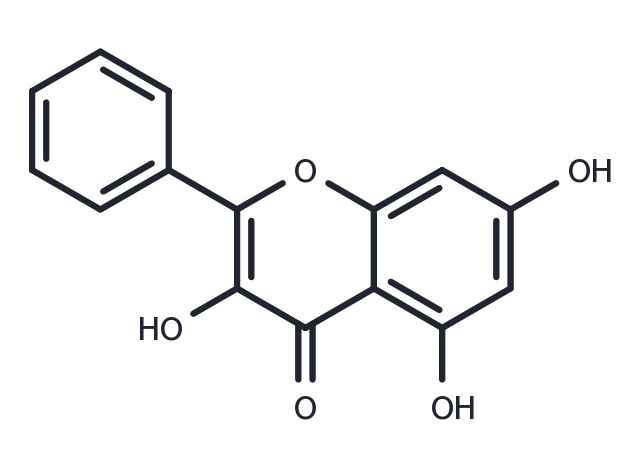Powder: -20°C for 3 years | In solvent: -80°C for 1 year


Galangin (Norizalpinin) is an agonist/antagonist of the arylhydrocarbon receptor, and also shows inhibition of CYP1A1 activity.

| Pack Size | Availability | Price/USD | Quantity |
|---|---|---|---|
| 5 mg | In stock | $ 30.00 | |
| 10 mg | In stock | $ 47.00 | |
| 25 mg | In stock | $ 77.00 | |
| 50 mg | In stock | $ 123.00 | |
| 100 mg | In stock | $ 217.00 | |
| 500 mg | In stock | $ 543.00 | |
| 1 mL * 10 mM (in DMSO) | In stock | $ 52.00 |






| Description | Galangin (Norizalpinin) is an agonist/antagonist of the arylhydrocarbon receptor, and also shows inhibition of CYP1A1 activity. |
| In vitro | Through thin-layer chromatography, it has been demonstrated that Galangin impedes the catabolic decomposition of DMBA in a dose-dependent fashion and obstructs the generation of DMBA-DNA adducts, thereby averting DMBA-related suppression of cell proliferation. Additionally, Galangin robustly curtails CYP1A1 enzyme activity in a dose-responsive manner within both intact cells and DMBA-exposed cell-derived microsomes, as ascertained through ethoxyresorufin-O-deethylase activity assays. The inhibition of CYP1A1 by Galangin occurs through a noncompetitive mechanism, as evidenced by double-reciprocal plot analysis. Moreover, Galangin elevates CYP1A1 mRNA levels, suggesting potential aryl hydrocarbon receptor agonism, yet it counteracts the DMBA or TCDD-triggered upregulation of CYP1A1 mRNA and promoter-driven transcription[1]. Furthermore, Galangin administration hampers cell proliferation while propelling autophagy at 130 μM and apoptosis at 370 μM. Specifically, in HepG2 cells, Galangin induces autophagosome accumulation, enhances microtubule-associated protein light chain 3 levels, and augments the proportion of vacuolated cells, alongside a surge in p53 expression. The Galangin-induced autophagic response is mitigated by p53 inhibition in HepG2 cells, while p53 overexpression in Hep3B cells normalizes the elevated vacuole presence[2]. |
| Cell Research | Cells (5.0×103) are seeded and treated with different concentrations of galangin for different periods of time in 96-well plates. The number of viable cells in each well is determined by adding 10 μL of 5 mg/mL MTT solution. Following the 4 hour incubation at 37°C, the cells are dissolved in a 100 μL solution containing 20% SDS and 50% dimethy formamide. The optical densities are quantified at a test wavelength of 570 nm with a reference wavelength of 630 nm using a Varioskan Flash Reader spectrophotometer. |
| Source |
| Synonyms | Norizalpinin, 3,5,7-Trihydroxyflavone |
| Molecular Weight | 270.24 |
| Formula | C15H10O5 |
| CAS No. | 548-83-4 |
Powder: -20°C for 3 years | In solvent: -80°C for 1 year
Chloroform, Dichloromethane, Ethyl Acetate, Acetone: Soluble
DMSO: 27 mg/mL(100 mM)
You can also refer to dose conversion for different animals. More
bottom
Please see Inhibitor Handling Instructions for more frequently ask questions. Topics include: how to prepare stock solutions, how to store products, and cautions on cell-based assays & animal experiments, etc.
Galangin 548-83-4 Autophagy MAPK Metabolism NF-Κb NF-κB ERK P450 inhibit Cytochrome P450 Inhibitor CYPs Norizalpinin 3,5,7-Trihydroxyflavone inhibitor
